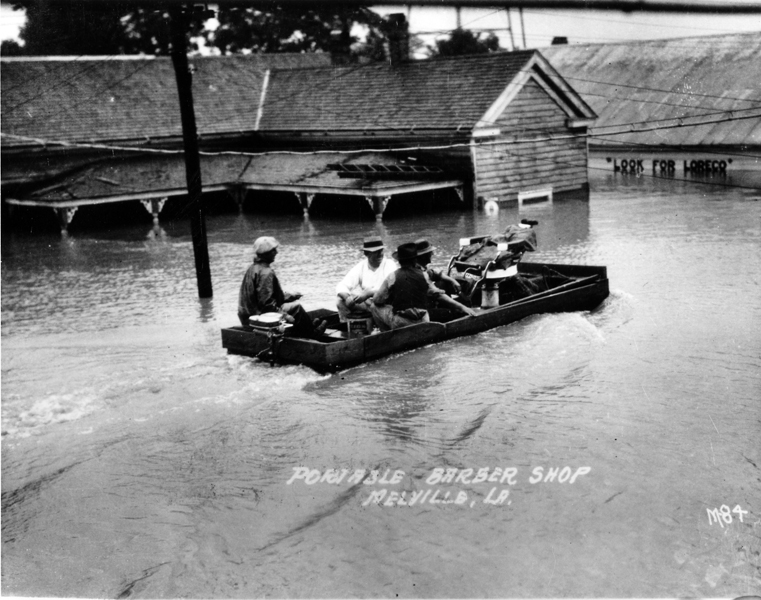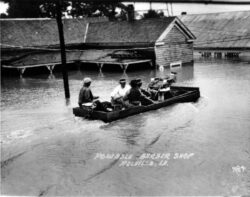Great Flood of 1927
The Great Flood of 1927 inundated more than ten thousand square miles across twenty Louisiana parishes and left tens of thousands of Louisianans without shelter.
This entry is 8th Grade level View Full Entry

State Library of Louisiana
A boat with a barber chair in Melville, Louisiana, during the Great Flood of 1927.
What were the causes of the Great Flood of 1927?
Rainstorms hit eastern Kansas, northwestern Iowa, and part of Illinois in August 1926, swelling streams flowing into the Mississippi River. In December, heavy rains in Oklahoma, Arkansas, and northern Louisiana filled the Arkansas and Red Rivers. The Mississippi River Valley experienced record rainfall that fall. By the end of January major tributaries like the Ohio River were overflowing. In earlier times swelling tributaries wouldn’t have been a major problem because the Mississippi River and its tributaries overflowed into natural drainage areas. But in the late 1800s, the Mississippi River Commission built levees that ran almost the entire length of the river. Levees prevented some previous flooding, but not the Flood of 1927.
How was the city of New Orleans affected by the flood?
New Orleans gets 4.4 inches of rain a month on average. In 1927 it rained 11.16 inches in New Orleans in February alone. On Good Friday, April 15, 1927, New Orleans got more than fourteen inches of rain in a single day. The rainwater disabled the pumps that usually drained the city and levees kept rainwater inside the city. That downpour also added more water to the Mississippi River as it rushed past New Orleans. The levees there were under pressure from both sides. Citizens started stockpiling food and buying boats. Armed levee patrols monitored the levees for breaks. More than twenty thousand men sandbagged levees between Baton Rouge and New Orleans as heavy rain continued.
State officials believed that the levees would eventually break, causing water from the Mississippi River to flood New Orleans. A break below New Orleans would spare the city from massive flooding. If the break happened upstream, however, New Orleans would experience disastrous flooding. Bankers and other business leaders urged Governor O. H. Simpson to destroy part of the levee downstream from New Orleans in order to spare the city. According to the plan, the floodwater would have a shortcut to the sea and thus New Orleans wouldn’t flood. Governor O. H. Simpson and his advisers agreed to the breach despite objections from people living downstream. On April 29, engineers started blowing apart the levee at Caernarvon in St. Bernard Parish. Over the next ten days workers used thirty-nine tons of dynamite to open a channel that released two hundred and fifty thousand cubic feet of water every second from the river.
In the two days prior to the dynamiting, the National Guard and major retailers from New Orleans evacuated ten thousand residents whose homes and livelihoods would be affected. Most of the people displaced from their homes went to stay with relatives. Those without a place to go were brought to a warehouse in New Orleans. Due to segregation white people were housed on the fifth floor, Black people on the sixth.
Those displaced by the destruction caused by dynamiting the levee were promised full compensation for their losses. However, some people received an average of only $274 each, and thousands more received nothing. Financial leaders in New Orleans estimated that the damage caused by the breech would cost $2–6 million. They set up a fund to prepare for this cost. Instead property losses equaled $35 million. In addition, providing food to those displaced cost $20,000 a week. The system set up to compensate people who experienced losses was difficult for many to navigate. Most weren’t fully compensated.
Adding to community anger, the blast had been unnecessary. After the blast a natural levee breach eased pressure on the New Orleans levee. People who lost property saw the flood as an avoidable, man-made catastrophe. The city of New Orleans was spared from disaster, but other parts of southern Louisiana to the west of the city weren’t so lucky.
How was the Atchafalaya Basin affected by the flood?
At Simmesport in Avoyelles Parish, the Atchafalaya River splits apart from the Mississippi River. In May 1927 two levee breaches caused disastrous flooding in Avoyelles Parish. The flood continued to spread. The town of Arnaudville, near the St. Landry–St. Martin Parish line, flooded on May 19. Breaux Bridge and St. Martinville in St. Martin Parish flooded two days later. Then New Iberia and Jeanerette in Iberia Parish and Franklin and Morgan City in St. Mary Parish flooded. By the end of May, sixty thousand people were either in camps for displaced people across South Louisiana or receiving Red Cross aid elsewhere. Thousands of cattle drowned, and farm crops were destroyed as southern Louisiana turned into a lake two hundred miles long and fifty to one hundred miles wide. The floodwaters didn’t drain into the Gulf of Mexico until June.
Tens of thousands of Louisianans were left without shelter. The Red Cross and local relief organizations set up tent cities and makeshift housing in Marksville, Mansura, Baton Rouge, Opelousas, Crowley, New Iberia, and elsewhere. Around twenty thousand people were housed in Lafayette alone. Parishes set up “rehabilitation committees” to find food and shelter for displaced families.
After the flood the Red Cross provided rations, seed, and tools to farm families. Prefabricated cabins were sent to St. Martin Parish and elsewhere to replace destroyed housing. At the end of August 1927, an Associated Press reporter touring the Teche region wrote, “Little farmhouses, bearing brown watermarks at various heights according to the depth of the water reached, are once more occupied, and some of the farmers are plowing in preparation for new plantings. A few have crops already growing, and cane and corn are making a brave attempt to put forth fruit despite the late start given them.”
What were the short-term effects of the Flood of 1927?
President Herbert Hoover described the 1927 flood as the “greatest peace-time calamity in the history of the country.” An estimated 931,159 people fled their homes after floodwaters inundated 16,570,627 acres in 170 counties and parishes in seven states. The Mississippi River stayed at flood stage for a record 153 days. The flood caused more than $400 million in losses; 92,431 businesses were damaged; and 162,017 homes were flooded. There were 250–500 flood-related deaths, according to various estimates. Louisiana alone had ten thousand square miles under water in twenty parishes. In response to the disaster, Congress passed the 1928 Flood Control Act. This response had long-term social, political, and physical effects across Louisiana and the Mississippi River Valley.
What were the long-term effects of the Flood of 1927?
The Flood of 1927 forced the federal government to rethink its flood control policy. The flood showed that levees alone wouldn’t stop flooding along the Mississippi River. A series of huge gates were built in south central and southeastern Louisiana to divert excess water into low-lying areas during times of flooding. Because these spillways were in the path of residential areas, whole communities, like Bayou Chêne, had to be abandoned. The Flood Control Act and later amendments poured money into the construction of a new levee system across the Lower Mississippi Valley. It also prompted the creation of reservoirs intended to slow down rainwater’s entry into the river and floodways, such as the Morganza Spillway in Pointe Coupee Parish, which could serve as safety valves in times of high water. It also funded US Army Corps of Engineers’ projects that straightened the river by cutting new paths through bends and other choke points in the river. These efforts moved water more efficiently downriver.
The flood drove many tenant farmers, most of whom were Black, off their land. Faced with the combined challenges of Jim Crow, the 1907–08 boll weevil infestation, and the devastation of the flood they migrated to Chicago, Detroit, and other northern cities by the thousands. The Flood of 1927 also gave Huey Long an opportunity to expand his voter base. Following the flood he used the experiences of rural, poor people in South Louisiana, especially those in St. Bernard and Plaquemines Parishes, to attack city leaders who had engineered the levee dynamiting. His sympathetic championing of victims led, in part, to his first successful run for governor.
